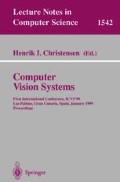Abstract
In this paper we propose a general layered model for the design of perception-action system. We discuss some desirable properties such a system must support to meet the severe constrains imposed by the expected behaviour of reactive systems. SVEX, a knowledge-based multilevel system, is used as a test prototype to implement and evaluate those considerations.
Additionally two aspects of the system are analyzed in detail in order to prove the benefits of the design criteria used in SVEX. These aspects refer to learning and distribution of computations. Finally, the results of some SVEX applications are shown.
This research is sponsored in part by Spanish CICYT under project TAP95-0288. The authors would also like to thank reviewers for their comments.
Access this chapter
Tax calculation will be finalised at checkout
Purchases are for personal use only
Preview
Unable to display preview. Download preview PDF.
References
Aloimonos J., Weis I., “ActiveVision”, Int. Journal of Computer Vision, 2, (1988), 333–356.
Bajcsi R., “ActivePerception”, Proc. of the IEEE, 76, 8, (1988), 996–1005.
Blum A. L., Langley P., “Selection of relevant features and examples in machine learning”, Artificial Intelligence, 97:245–271, 1997.
Buchanan B., “Can Machine Learning Offer Anything to Expert Systems?”, Machine Learning, 4, pp. 251–254, 1989.
Cabrera J., “Sistema Basado en Conocimiento para Segmentación de Imágenes. Desarrollos y Aplicaciones”, Doctoral Dissertation, Universidad de Las Palmas de Gran Canaria, 1994.
Cabrera J., Hernández F.M., Falcón A., Méndez J., “Contributions to the symbolic processing of segments in computer vision”, Mathware and Soft Computing, III(3):403–413, 1996.
Cohn D., Atlas L., Ladner R., “Improving Generalization with Active Learning”, Machine Learning, 15, pp. 201–221, 1994.
Devijver P. A., Kittler J., Pattern Recognition: A Statistical Approach. Prentice-Hall, Englewood Cliffs, New Jersey, 1982.
Dubois D., Prade H., Yager R. R., Introduction in Readings in Fuzzy Sets for Intelligent Systems, Morgan Kaufmann Pub., (1993), 1–20.
Duda R., Hart P., Pattern Classification and Scene Analysis, Wiley, 1973.
Fukunaga K., Introduction to Statistical Pattern Recognition. Academic Press Inc., 2nd edition, 1990.
Geist A., PVM: Parallel Virtual Machine-A Users’ Guide and Tutorial for Net-worked Parallel Computing, The MIT Press, 1994.
Gordon J., Shortliffe E.H., “The Dempster-Shafer Theory of Evidence”, in Rule-Based Expert Systems, Buchanan and Shortliffe (Eds.), (1984), 272–292.
Koller D., Sahami M., “Toward optimal feature selection”, Proc. of the 13th Int. Conf. on Machine Learning, pages 284–292. Morgan Kaufmann, 1996.
Krisnapuram R., Keller J.M., “Fuzzy Set Theoretic Approach to Computer Vision: An Overview”, in Fuzzy Logic Technology and Applications, IEEE Tech. Activities Board, (1994), 25–32.
Hernández D., Cabrera J., “Distribution of Image Processing Application on a Heterogeneous Workstation Network. Modeling, Load-balancing and Experimental Results”, SPIE-97 Parallel on Distributed Methods for Image Processing, vol. 3166, pp. 170–179, July 1997, San Diego.
Huntsberger T.L., Rangarajan C., Jayaramamurthy S.N., “Representation of Uncertainty in Computer Vision using Fuzzy Sets”, IEEE Trans. Comput., 35, 2, (1986), 145–156.
Lee. S., Kil R. M., “Multilayer Feedforward Potential Function Network”, Proc. of 2nd. Int. Conf. on Neural Networks, vol I, pp. 161–171, 1988.
Lorenzo J., Hernández M., Méndez J., “An information theory-based measure to assess feature subsets”, Preprints of the VII National Symposium on Pattern Recognition and Image Analysis (AERFAI’97), volume 2, pages 38–39, 1997.
Lorenzo J., Hernández M., J. Méndez. “A measure based on information theory for attribute selection”, (IBERAMIA-98) 6th Ibero-American Conference on Artificial Intelligence, Lisbon, Portugal, Lectures Notes in Artificial Intelligence, Springer Verlag, October 1998.
Méndez J., Falcón A., Hernández F.M., Cabrera J., “A Development Tool for Computer Vision Systems at Pixel Level”, Cybernetics & Systems, 25, 2, (1994), 289–316.
Munro D., “Performance of Multiprocessor Communications Networks”, Doctoral Dissertation, Dep. of Electronics, University of York, 1994.
Niemann H., Brünig H., Salzbrunn R., Schröder S., “A Knowledge-Based Vision System for Industrial Applications”, Machine Vision and Applications, 3, (1990), 201–229.
Pennington R., “Distributed and Heterogeneous Computing”, Cluster Computing Lecture Series, Pittsburg Supercomputing Center 1995.
Poggio T., Girosi F., “Networks for approximation and learning”, Proceedings of the IEEE, 78:1481–1487, 1990.
Quinlan J.R., “Induction of decision trees”, Machine Learning, 1:81–106, 1986.
Renals S., Rohwer R., “Phoneme Classification Experiments using Radial Basis Functions”, Proc. Int. Conf. on Neural NetworksI, pp. 416–467, 1989.
Rosenblatt F., “On the Convergence of Reinforcement Procedures in Simple Perceptrons”, Cornell Aeronautical Report VG-1196-G-4, Buffalo, NY, 1960.
Risemann E.M., Hanson A.R., “A Methodology for the Development of General Knowledge-Based Vision Systems”, in Vision, Brain and Cooperative Computation, MIT Press, Cambridge Mass., (1987), 285–328.
Rumelhart D. E., Hinton G. E., Willians R. J., “Learning Representations by Back-Propagating Errors”, Nature, 323, pp. 533–536, 1986.
Vincent L., Soille P., “Watersheds in Digital Spaces: An efficient algorithm based on immersion simulations”. IEEE Trans. on Pattern Anal. and Mach. Intell., Vol 13, n 6, pp. 583–598, 1991.
Wilson R., Spann M., Image Segmentation and Uncertainty, Research Studies Press Ltd., 1988.
Zadeh L.A., “PRUF-A meaning representation language for natural languages”, in Fuzzy Reasoning and its Applications, Academic Press, London, (1981), 1–39.
Zadeh L.A., “Commonsense Knowledge Representation based on Fuzzy Logic”, IEEE Computer, 16, 10, (1983), 61–65.
Zhang B., “Accelerated Learning by Active Example Selection”, International Journal of Neural Networks, vol. 5(1), pp. 67–75, 1994.
Author information
Authors and Affiliations
Rights and permissions
Copyright information
© 1999 Springer-Verlag Berlin Heidelberg
About this paper
Cite this paper
Hernández-Sosa, D., Lorenzo-Navarro, J., Hernández-Tejera, M., Cabrera-Gámez, J., Falcón-Martel, A., Méndez-Rodríguez, J. (1999). A Generic Model for Perception-Action Systems. Analysis of a Knowledge-Based Prototype. In: Computer Vision Systems. ICVS 1999. Lecture Notes in Computer Science, vol 1542. Springer, Berlin, Heidelberg. https://doi.org/10.1007/3-540-49256-9_18
Download citation
DOI: https://doi.org/10.1007/3-540-49256-9_18
Published:
Publisher Name: Springer, Berlin, Heidelberg
Print ISBN: 978-3-540-65459-9
Online ISBN: 978-3-540-49256-6
eBook Packages: Springer Book Archive

